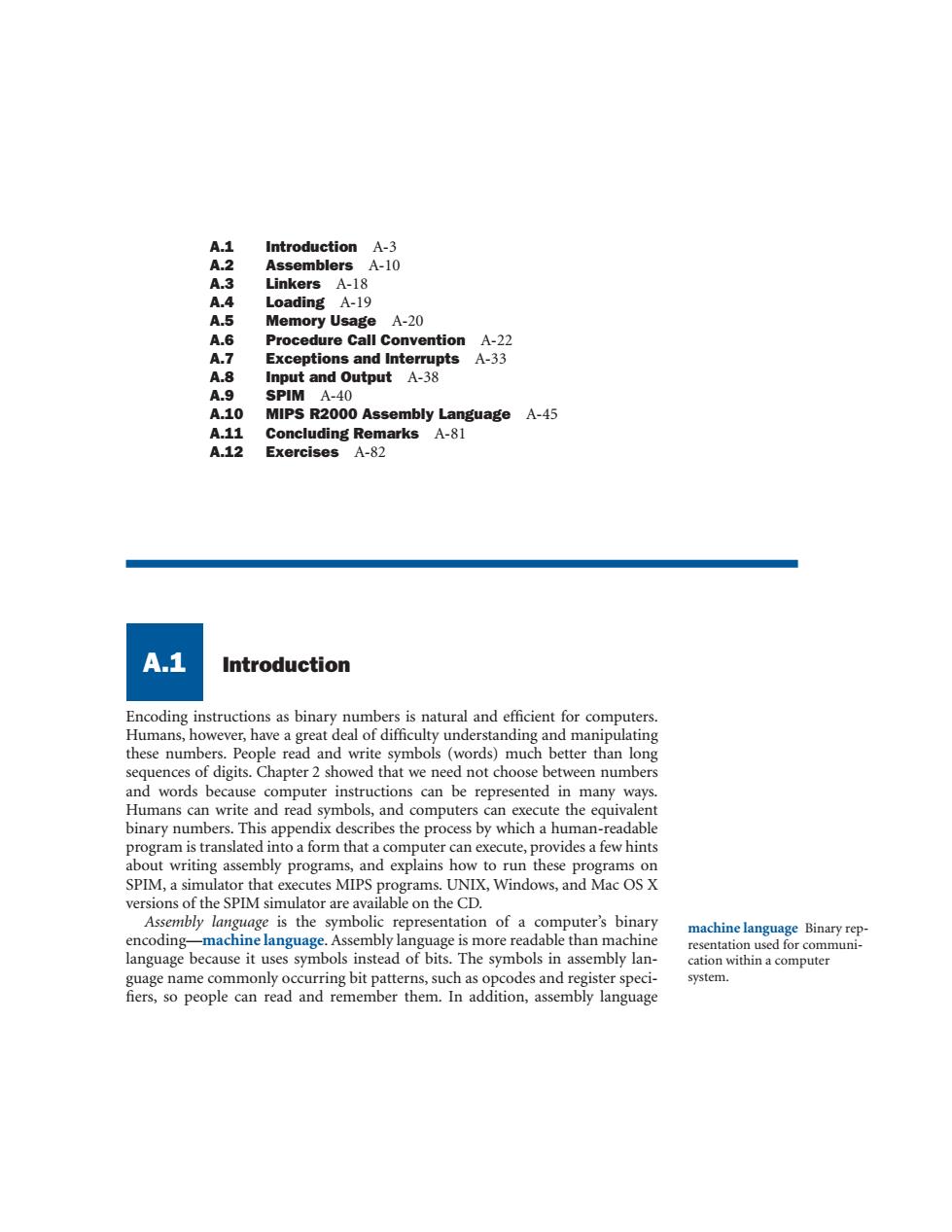正在加载图片...

A.1 Introduction A-3 A.2 Assemblers A-10 A.3 Linkers A-18 A.4 Loading A-19 A.5 Memory Usage A-20 A.6 Procedure Call Convention A-22 A.7 Exceptions and Interrupts A-33 A.8 Input and Output A-38 A.9 SPIM A-40 A.10 MIPS R2000 Assembly Language A-45 A.11 Concluding Remarks A-81 A.12 Exercises A-82 A.1 Introduction Encoding instructions as binary numbers is natural and efficient for computers. Humans,however,have a great deal of difficulty understanding and manipulating these numbers.People read and write symbols (words)much better than long sequences of digits.Chapter 2 showed that we need not choose between numbers and words because computer instructions can be represented in many ways. Humans can write and read symbols,and computers can execute the equivalent binary numbers.This appendix describes the process by which a human-readable program is translated into a form that a computer can execute,provides a few hints about writing assembly programs,and explains how to run these programs on SPIM,a simulator that executes MIPS programs.UNIX,Windows,and Mac OS X versions of the SPIM simulator are available on the CD. Assembly language is the symbolic representation of a computer's binary encoding-machine language.Assembly language is more readable than machine machine language Binary rep- resentation used for communi- language because it uses symbols instead of bits.The symbols in assembly lan- cation within a computer guage name commonly occurring bit patterns,such as opcodes and register speci- system. fiers,so people can read and remember them.In addition,assembly languageA.1 Introduction A-3 A.2 Assemblers A-10 A.3 Linkers A-18 A.4 Loading A-19 A.5 Memory Usage A-20 A.6 Procedure Call Convention A-22 A.7 Exceptions and Interrupts A-33 A.8 Input and Output A-38 A.9 SPIM A-40 A.10 MIPS R2000 Assembly Language A-45 A.11 Concluding Remarks A-81 A.12 Exercises A-82 Encoding instructions as binary numbers is natural and efficient for computers. Humans, however, have a great deal of difficulty understanding and manipulating these numbers. People read and write symbols (words) much better than long sequences of digits. Chapter 2 showed that we need not choose between numbers and words because computer instructions can be represented in many ways. Humans can write and read symbols, and computers can execute the equivalent binary numbers. This appendix describes the process by which a human-readable program is translated into a form that a computer can execute, provides a few hints about writing assembly programs, and explains how to run these programs on SPIM, a simulator that executes MIPS programs. UNIX, Windows, and Mac OS X versions of the SPIM simulator are available on the CD. Assembly language is the symbolic representation of a computer’s binary encoding—machine language. Assembly language is more readable than machine language because it uses symbols instead of bits. The symbols in assembly language name commonly occurring bit patterns, such as opcodes and register speci- fiers, so people can read and remember them. In addition, assembly language A.1 Introduction A.1 machine language Binary representation used for communication within a computer system